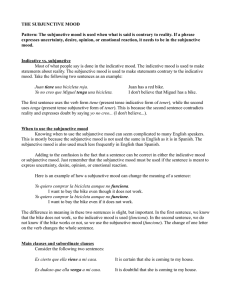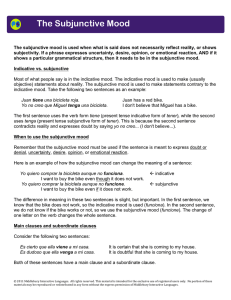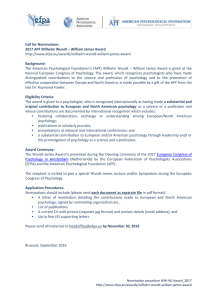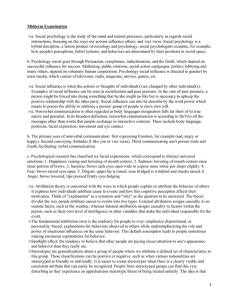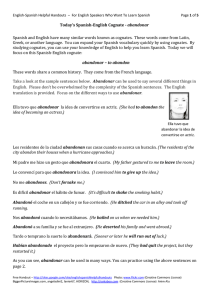Science Current Directions in Psychological
Anuncio
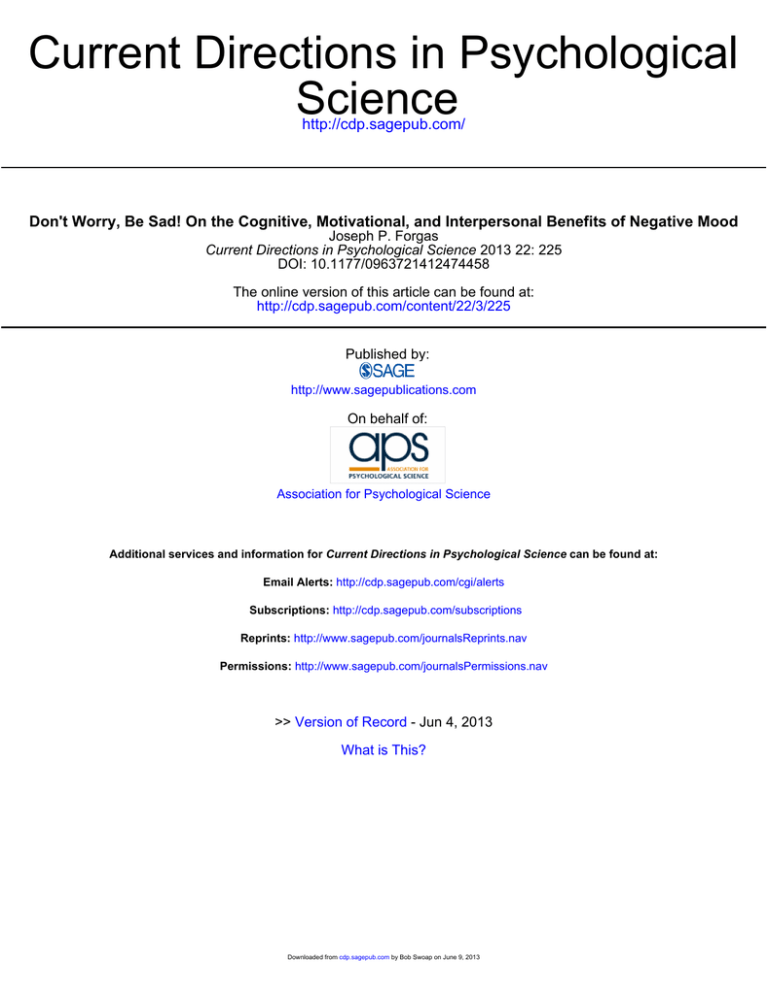
Current Directions in Psychological Science http://cdp.sagepub.com/ Don't Worry, Be Sad! On the Cognitive, Motivational, and Interpersonal Benefits of Negative Mood Joseph P. Forgas Current Directions in Psychological Science 2013 22: 225 DOI: 10.1177/0963721412474458 The online version of this article can be found at: http://cdp.sagepub.com/content/22/3/225 Published by: http://www.sagepublications.com On behalf of: Association for Psychological Science Additional services and information for Current Directions in Psychological Science can be found at: Email Alerts: http://cdp.sagepub.com/cgi/alerts Subscriptions: http://cdp.sagepub.com/subscriptions Reprints: http://www.sagepub.com/journalsReprints.nav Permissions: http://www.sagepub.com/journalsPermissions.nav >> Version of Record - Jun 4, 2013 What is This? Downloaded from cdp.sagepub.com by Bob Swoap on June 9, 2013 474458 research-article2013 CDPXXX10.1177/0963721412474458ForgasDon’t Worry, Be Sad! Don’t Worry, Be Sad! On the Cognitive, Motivational, and Interpersonal Benefits of Negative Mood Current Directions in Psychological Science 22(3) 225­–232 © The Author(s) 2013 Reprints and permissions: sagepub.com/journalsPermissions.nav DOI: 10.1177/0963721412474458 cdps.sagepub.com Joseph P. Forgas School of Psychology, University of New South Wales Abstract This article reviews recent evidence for the benefits of negative affect for thinking and behavior, consistent with evolutionary theories suggesting an adaptive function for all affective states. Numerous experiments demonstrate that negative affect can improve memory performance, reduce judgmental errors, improve motivation, and result in more effective interpersonal strategies. These findings are interpreted in terms of dual-process theories that predict that positive affect promotes more assimilative, internally focused processing styles, whereas negative affect promotes a more accommodative and externally focused thinking strategy. The theoretical relevance of these findings for recent affect-cognition models is discussed, and the practical implications of recognizing the adaptive benefits of negative affect for social thinking and performance in a number of applied fields are considered. Keywords mood, benefits of negative affect, social cognition, memory, judgments, interpersonal behavior Humans are a moody species, and our ever-changing moods serve as helpful input informing our cognitive and motivational strategies (Adolphs & Damasio, 2001; Forgas, Haselton, & von Hippel, 2007). Although dysphoria has always been with us and has stimulated many of the greatest achievements of the human spirit, our current cultural epoch is characterized by a unilateral emphasis on the benefits of happiness (Gruber, 2011; Whippman, 2012). Yet, negative mood remains an essential component of our affective repertoire, and experiences of temporary dysphoria have always been considered normal in previous historical periods. From classical Greek tragedies through Shakespeare to the works of Beethoven, Checkhov, Ibsen, and the great novels of the 19th century, evoking and exploring the landscape of sadness has long been recognized as instructive and valuable. Fortunately, the adaptive functions of negative mood are now receiving growing attention in psychology (Forgas & Eich, in press). It is the effects of moods rather than distinct emotions that are of interest here, as moods are more common, are more enduring, and produce more uniform and reliable consequences than do more context-specific emotions. Moods may be defined as lowintensity, diffuse, and relatively enduring affective states without a salient antecedent cause and, therefore, little conscious cognitive content. In contrast, emotions are more intense, are short-lived, and have a definite cause and conscious cognitive content (Forgas, 1995, 2002). In this article, I review extensive evidence from our laboratory showing that negative moods often recruit a more attentive, accommodating thinking style that provides superior outcomes whenever externally oriented, inductive processing is required (Forgas & Eich, in press), consistent with the principle that all affective states exist “for the sake of signalling [sic] states of the world that have to be responded to” (Frijda, 1988, p. 354). Background and Theories Following major advances in physiology and neuroscience, it is now known that affect is often an essential and adaptive component of responding to situations. Current theories identify two kinds of affective influences: (a) Corresponding Author: Joseph P. Forgas, School of Psychology, University of New South Wales, Sydney, NSW 2052, Australia E-mail: jp.forgas@unsw.edu.au Downloaded from cdp.sagepub.com by Bob Swoap on June 9, 2013 Forgas 226 informational effects (such as affect congruence), when an affective state influences the valence of responses, and (b) processing effects, when affect influences the way information is processed. Informational effects According to the affect-priming account (Bower, 1981), affect is integrally linked to an associative network of memory representations, and affective states can selectively prime associated constructs that are more likely to be used in subsequent constructive cognitive tasks. Early studies confirmed clear mood-congruent effects on memory, social judgments, and behavior. A different affect-asinformation model suggests that instead of computing a judgment on the basis of recalled features of a target, individuals may often ask themselves, “How do I feel about it?”, and in doing so, they may often misattribute their current feelings as indicative of their reaction to the target (Schwarz, 1990, p. 529). Both accounts can explain affect congruence, albeit in different circumstances (see Forgas, 2002). Integrative theories, such as the affect infusion model (Forgas, 1995, 2002), further specify that affect congruence should depend on the processing styles recruited by different situations: Affect-as-information is the mechanism of affect infusion only when heuristic processing is adopted, and affect priming operates only when substantive, constructive information processing is used. Processing effects Affect may also influence processing strategies. Early evidence suggested that positive mood leads to less effortful processing (Clark & Isen, 1982). More recent theories show, however, that rather than just influencing processing effort, mood has an adaptive function recruiting qualitatively different processing styles. According to Bless and Fiedler’s (2006; Fiedler, 2001) assimilative/ accommodative theory, moods signal whether a situation poses assimilative opportunities or accommodative challenges to the self. Moods thus subconsciously regulate the relative influence of top-down processes (in positive mood) and bottom-up processes (in negative mood). Positive mood signals that the environment is familiar or benign, and so top-down, assimilative processing is appropriate using preexisting knowledge to interpret the situation. In contrast, negative mood signals a new or challenging situation calling for externally focused, bottom-up and accommodative processing in which people follow social norms and attend to concrete stimuli to interpret the situation (Bless & Fiedler, 2006; Fiedler, 2001; Forgas, 2002, 2010). Thus, assimilation promotes “imposing internal structures on the external world,” and accommodation involves “modifying internal structures in accordance with external constraints” (Bless & Fiedler, 2006, p. 66). Numerous studies show that negative mood reduces reliance on preexisting knowledge, such as scripts, traits, stereotypes, and constructive impressions (Bless, Schwarz, Clore, Golisano, & Rabe, 1996; Bodenhausen, Mussweiler, Gabriel, & Moreno, 2011; Fiedler, Asbeck, & Nickel, 1991; Forgas, 2011b; Forgas & Koch, 2013). The Benefits of Negative Affect Evidence for the benefits of negative affect, including a series of experiments from our laboratory, is summarized in four sections: (a) memory benefits, (b) judgmental benefits, (c) motivational benefits, and (d) interpersonal benefits. In these experiments, participants are first induced into a positive or negative mood state (e.g., using films, music), and the effects of mood on subsequent cognitive and behavioral tasks are systematically assessed. Improved memory Memory is probably the most fundamental cognitive faculty (Forgas & Eich, in press; Loftus, 1979). Negative mood, by recruiting more accommodative and externally focused processing, should improve attention and encoding. We found, for example, that shoppers in a small suburban shop remembered significantly more information about the interior of the shop when they experienced negative mood (on rainy, cold days) rather than positive mood (on sunny, warm days), even though the time they spent in the shop was controlled for (Forgas, Goldenberg, & Unkelbach, 2009). Memory accuracy can sometimes be compromised by the incorporation of later, misleading information into the original memory trace (Loftus, 1979). Several experiments found that negative mood participants were less likely to incorporate false, misleading details into their memories than were happy participants (Forgas, Vargas, & Laham, 2005). In one experiment, participants witnessed a realistic staged altercation between a lecturer and a female intruder (Forgas et al., 2005, Experiment 2). One week later, while in a happy or sad mood, they received questions containing misleading information about the incident. Negative mood reduced the constructive tendency to incorporate misleading information and produced more accurate eyewitness memories, consistent with a more accommodative processing style (see Figure 1). Related effects were also demonstrated by Bauml and Kuhbandner (2007), who found that negative affect Downloaded from cdp.sagepub.com by Bob Swoap on June 9, 2013 Don’t Worry, Be Sad! 2.5 leading 227 False Alarms 5.5 non-leading Introvert first Extravert first 5 2 4.5 1.5 4 1 3.5 0.5 3 0 happy sad neutral Fig. 1. Mood effects on the tendency to incorporate misleading information into eyewitness memory: negative mood reduced, and positive mood increased, the tendency to incorporate false, misleading memories into eyewitness recollections (false alarms; after Forgas, Vargas, & Laham, 2005). reduced memory interference by promoting item-specific processing. Storbeck and Clore (2011) also reported that sad mood reduced false memories by reducing the activation of nonpresented lures, consistent with other evidence that negative affect restricts the activation of mental representations (Clore & Huntsinger, 2009). Improved judgmental accuracy Social judgments are subject to a variety of constructive biases as judges create a meaningful “Gestalt” from the information they receive (Asch, 1946). For example, primacy effects occur because people place disproportionate emphasis on early information and ignore later details (Asch, 1946). In one experiment, happy or sad judges were asked to form impressions about a person, Jim, after reading two paragraphs describing him as an extrovert or an introvert (Luchins, 1958). The order of the paragraphs was counterbalanced. We found clear primacy effects, but remarkably, negative mood completely eliminated this pervasive judgmental bias (Forgas, 2011b; see Figure 2). Impression formation can also be biased by halo effects. For example, a good-looking person might be judged as having more desirable qualities, or a young unorthodox-looking woman is less likely to be seen as a competent philosopher than a middle-aged man. We used this manipulation in a recent experiment (Forgas, 2011c). After an autobiographical mood induction (reminiscing about happy or sad past events), judges in a positive or negative mood read a one-page philosophical Happy Control Sad Fig. 2. The effects of mood and primacy on the evaluation of a target person: positive mood increased, and negative mood reduced, the constructive tendency to rely on early information (primacy effect) in impressions (evaluative judgments shown on vertical axis; after Forgas, 2011b). essay. I also attached a photo of the writer showing either a casually dressed woman or a tweedy, bespectacled man. Happy judges were significantly more influenced by the appearance of the target, but negative mood eliminated this halo effect (Forgas, 2011c). More attentive processing in negative mood should also reduce a person’s likelihood to succumb to inferential biases, such as the fundamental attribution error— the tendency to infer intentionality and ignore situational factors (Forgas, 1998). In several experiments, happy or sad participants were asked to read and make inferences about the writer of an essay advocating popular or unpopular positions that were either assigned or freely chosen by the writer (Forgas, 1998). Participants in a negative mood (after watching films) were significantly less likely to infer incorrect, internal causation on the basis of coerced essays, and they also had better memory for essay details, consistent with their more accommodative processing style. Conceptually similar effects were also reported by Fiedler, Asbeck, and Nickel (1991), who found that negative mood reduced, and positive mood increased, constructive impression formation biases, such as the incorporation of irrelevant information introduced by questioning into subsequent impressions. Reduced gullibility Several experiments also have shown that negative moods have an overall beneficial influence on reducing gullibility and increasing skepticism when it comes to judging the likely truth of a number of urban myths and Downloaded from cdp.sagepub.com by Bob Swoap on June 9, 2013 Forgas 228 0.9 deceptive at correctly detecting deceptive targets (Forgas & East, 2008b; see Figure 3). Sad participants were also significantly less likely to accept facial expressions as genuine than were people in the neutral or happy condition, consistent with the more attentive and accommodative processing style associated with negative moods. truthful Average guilt judgments 0.8 0.7 0.6 0.5 0.4 Reduced stereotyping 0.3 0.2 0.1 0 happy neutral interview type sad Fig. 3. The effects of mood and the target’s veracity (truthful, deceptive) on judgments of guilt of targets accused of committing a theft (average percentage of targets judged guilty in each condition; negative affect significantly improved the ability to detect deception; after Forgas & East, 2008b). rumors (Forgas & East, 2008a). Subjective ease of processing, or fluency, is one of the most influential implicit cues people use when judging truth. We found that positive mood increased, and negative mood decreased, reliance on such internal fluency cues in truth judgments (Koch & Forgas, in press). As negative affect improves attention to stimulus details, it may also improve a person’s ability to detect deception. When happy or sad participants watched a videotape of an interrogation of a person accused of theft, those in a negative mood were more likely to make guilty judgments, and they were also significantly better Negative mood can also inhibit the implicit use of stereotypes. In one study, participants in positive or negative mood were asked to shoot at targets only when they carried a gun. Targets also did or did not appear Muslim (wearing or not wearing a turban; see Figure 4). There was a significantly greater tendency overall to shoot at Muslims; however, negative affect actually reduced, and positive affect increased, this discriminative tendency, consistent with negative mood recruiting a more accommodative processing style and closer attention to actual stimulus features rather relying on internal stereotypes (Bless & Fiedler, 2006). Other studies also have shown that whereas positive affect increases stereotyping in judgments, “negative affective states (specifically, sadness) are associated with reductions or elimination of stereotypic biases” (Bodenhausen et al., 2011, p. 337). Motivational benefits According to the hedonistic discounting theory, positive affect should diminish, and negative mood should increase, the expected hedonistic value of future achievement (Goldenberg & Forgas, 2012). When happy and sad participants were asked to persevere at a demanding Fig. 4. The turban effect: Stimulus figures used to assess the effects of mood and wearing or not wearing a turban on subliminal aggressive responses. Respondents in a positive mood were more likely, and those in a negative mood were less likely, to rely on Muslim stereotypes and to shoot at turbaned targets (after Unkelbach, Forgas, & Denson, 2008). Downloaded from cdp.sagepub.com by Bob Swoap on June 9, 2013 Don’t Worry, Be Sad! 229 cognitive task as long as they liked, those in negative mood persevered more—they spent more time on the task, attempted more questions, and had more correct answers. A mediational analysis supported the hedonistic discounting theory, as greater perseverance in negative mood was indeed linked to increased task-value beliefs. Negative affect may also reduce, and positive affect increase, the tendency to create artificial self-handicaps when success is uncertain on a task. Happy or sad participants who doubted their ability to do well on a later task were given a choice to (a) drink a performanceenhancing, or inhibiting, herbal tea, and (b) engage or not in performance-enhancing practice. Happy mood increased, and negative mood decreased, the incidence of self-handicapping on both measures, as predicted by the hedonistic discounting theory. Thus, in some circumstances, negative affect can increase perseverance and can reduce dysfunctional self-handicapping behaviors (Alter & Forgas, 2007; Goldenberg & Forgas, 2012). Fig. 5. Negative mood increased politeness in naturally produced requests: positive mood reduced, and negative mood increased, the degree of politeness, elaboration, and hedging in strategic interpersonal requests (after Forgas, 1999). Interpersonal benefits Increased fairness Negative affect might also produce a variety of interpersonal benefits, as it primes access to more cautious and considered interpretations and results in more polite and attentive interpersonal strategies (Forgas, 1995, 2002). For example, requests must be formulated with just the right degree of politeness to be effective. It turns out that negative mood primes more cautious and careful expectations and leads to more polite and elaborate requests, whereas positive mood produces less polite and more assertive approaches (Forgas, 1999). These mood effects also occur in real-life settings using an unobtrusive method. When happy or sad participants (after watching films) were unexpectedly asked to get a file from a neighboring office, negative mood resulted in more polite, elaborate, and hedging requests (see Figure 5). Other work suggests that speakers in a negative mood also follow more closely Grice’s (1975) conversational postulates and provide higher quality, more concrete, and more detailed descriptions of observed events (Koch, Forgas, & Goldenberg, 2012; Koch, Forgas, & Matovic, 2012). Of course, more cautious and polite strategies are not always advantageous. In other situations, positive affect may result in more confident negotiating strategies (Forgas, 2002) and more effective self-disclosure (Forgas, 2011a). There is also growing evidence that moods often have an automatic influence on interpersonal strategies, with positive mood promoting, and negative affect limiting, spontaneous internal processes, such as non­ conscious mimicry (Van Baaren, Fockenberg, Holland, Janssen, & van Knippenberg, 2006) and the automatic corepresentation of other individuals’ actions (Kuhbandner, Pekrun, & Maier, 2010). Selfishness and fairness are basic dimensions of relating to others. The assimilative/accommodative model implies that positive mood may increase self-focus and selfishness, and negative mood can enhance focus on external fairness norms. When people have to divide a scarce resource between themselves and others, as is the case in the dictator game, we found that happy allocators were more selfish, and sad allocators were more fair, and these mood effects became stronger as allocation trials progressed (Tan & Forgas, 2010; see Figure 6). In the ultimatum game, proposers face a responder who has a veto power to accept or reject the offer. If rejected, neither side gets anything. In this more complex decisional environment, sad participants were again less selfish and gave more resources to others than did happy individuals. They also took longer to make fair decisions, consistent with the predicted differences in processing style. Surprisingly, negative mood also increased concern with fairness by responders, who were more likely to reject unfair offers than were happy responders (Forgas & Tan, in press). These results again demonstrate that negative affect may increase concern for others and increase fairness. 5 Happy Control Sad Mean Rating 4 3 2 1 0 Elaboration Politeness Hedging Request Quality More effective persuasion Closer attention to external information may also improve interpersonal effectiveness, such as the quality of persuasive messages (Forgas, 2007). When happy or sad participants were asked to write persuasive arguments for or against controversial issues (e.g., an increase in student fees), those in a negative mood produced higher quality Downloaded from cdp.sagepub.com by Bob Swoap on June 9, 2013 Forgas 230 Summary and Conclusions These studies offer convergent evidence for the often adaptive, beneficial effects of negative affect for cognition, judgments, motivation, and social behavior. The results are consistent with evolutionary theories that suggest that all of our affective states—including the unpleasant ones—function as “mind modules” that produce adaptive benefits in some circumstances (Forgas, Haselton, & von Hippel, 2007; Frijda, 1988; Tooby & Cosmides, 1992). These findings stand in stark contrast with the unilateral emphasis on the benefits of positive affect in the recent literature as well as in popular culture. It is now increasingly recognized that positive affect, despite some advantages, is not universally desirable (Frederickson, 2001; Gruber, 2011). Rather, people in a negative mood may be less prone to judgmental errors (Forgas, 1998), more resistant to eye-witness distortions (Forgas et al., 2005), more motivated (Goldenberg & Forgas, 2012), more sensitive to social norms (Forgas, 1999), and better at producing highquality and effective persuasive messages (Forgas, 2007). Happy No. of Points Kept to Self 8 Sad 7 6 5 4 1 2 3 4 5 Number of Trials 6 7 8 Fig. 6. The effects of mood on selfishness versus fairness in the dictator game: negative mood increased fairness and reduced selfishness, as negative mood participants kept fewer rewards to themselves and gave more to their partners; this effect became more pronounced as trials progressed (after Tan & Forgas, 2010). 8 Positive Neutral Negative 7 Mean Argument Quality and more persuasive arguments than did happy participants. Their arguments featured more concrete and tangible information, consistent with a more accommodative processing style (see Figure 7). I subsequently found that arguments produced by sad persuaders actually worked better in producing real attitude change in naïve participants. These experiments confirm that negative affect can actually improve the quality and effectiveness of interpersonal strategies in some situations. 6 5 4 Quality Concreteness Fig. 7. Mood effects on the quality and concreteness of the persuasive messages produced: negative affect increased the degree of concreteness of the arguments produced, and arguments produced in negative mood were also more effective in producing attitude change (after Forgas, 2007, Experiment 2). Error bars indicate the standard error of the mean. Of course, negative affect is not always desirable. The beneficial effects of dysphoria are most obvious when negative affect produces greater attention to situational demands or improves motivation. Intense, enduring, or debilitating dysphoria offers no such benefits. I demonstrated the cognitive, motivational, and interpersonal benefits of mild, temporary mood states here, of the kind that people all regularly experience in everyday life. Specific, intense emotions may have very different consequences. The evidence shows that in many situations, negative affect may increase, and positive affect may decrease, people’s ability to monitor and adapt to situational requirements. Applied and clinical professionals might well benefit from an explicit recognition of the adaptive functions of negative affect. More generally, these results suggest that the unrelenting pursuit of happiness may often be self-defeating (Gruber, 2011; Whippman, 2012), and a more balanced assessment of the costs and benefits of positive and negative affect is long overdue in professional practice and in popular culture as well. Recommended Reading Bless, H., & Fiedler, K. (2006). (See References). A comprehensive model explaining the different processing consequences of positive and negative moods. Forgas, J. P. (2001). (See References). An overview of research on affective influences on social behaviour. Downloaded from cdp.sagepub.com by Bob Swoap on June 9, 2013 Don’t Worry, Be Sad! 231 Forgas, J. P., & Eich, E. E. (in press). (See References). A comprehensive review of research on the informational and processing effects of affective states. Gruber, J. (2011). (See References). An up-to-date summary of evidence for the negative consequences of positive affective states. Author’s Note For further information on this research program, see the following two Web sites: (a) http://forgas.socialpsychology.org and (b) http://www2.psy.unsw.edu.au/Users/JForgas. Declaration of Conflicting Interests The author declared no conflicts of interest with respect to the authorship or the publication of this article. Funding Support from the Australian Research Council is gratefully acknowledged. References Adolphs, R., & Damasio, A. (2001). The interaction of affect and cognition: A neurobiological perspective. In J. P. Forgas (Ed.), The handbook of affect and social cognition (pp. 27– 49). Mahwah, NJ: Erlbaum. Alter, A., & Forgas, J. P. (2007). On being happy but fearing failure: The effects of mood on self-handicapping strategies. Journal of Experimental Social Psychology, 43, 947– 954. Asch, S. E. (1946). Forming impressions of personality. Journal of Abnormal and Social Psychology, 41, 258–290. Bauml, K. H., & Kuhbandner, C. (2007). Remembering can cause forgetting—But not in negative moods. Psychological Science, 18, 111–115. Bless, H., & Fiedler, K. (2006). Mood and the regulation of information processing and behavior. In J. P. Forgas (Ed.), Affect in social thinking and behavior (pp. 65–84). New York, NY: Psychology Press. Bless, H., Schwarz, N., Clore, G. L., Golisano, V., & Rabe, C. (1996). Mood and the use of scripts: Does a happy mood really lead to mindlessness? Journal of Personality and Social Psychology, 71, 665–679. Bodenhausen, G. V., Mussweiler, T., Gabriel, S., & Moreno, K. N. (2011). Affective influences on stereotyping and intergroup relations. In J. P. Forgas (Ed.), The handbook of affect and social cognition (pp. 319–344). Mahwah, NJ: Erlbaum. Bower, G. H. (1981). Mood and memory. American Psychologist, 36, 129–148. Clark, M. S., & Isen, A. M. (1982). Towards understanding the relationship between feeling states and social behavior. In A. H. Hastorf & A. M. Isen (Eds.), Cognitive social psychology (pp. 73–108). New York, NY: Elsevier-North Holland. Clore, G. L., & Huntsinger, J. R. (2009). How the object of affect guides its impact. Emotion Review, 1, 39–54. Fiedler, K. (2001). Affective states trigger processes of assimilation and accommodation. In L. L. Martin & G. L. Clore (Eds.), Theories of mood and cognition: A user’s guidebook (pp. 85–98). Mahwah, NJ: Erlbaum. Fiedler, K., Asbeck, J., & Nickel, S. (1991). Mood and constructive memory effects on social judgment. Cognition & Emotion, 5, 363–378. Forgas, J. P. (1995). Mood and judgment: The Affect Infusion Model (AIM). Psychological Bulletin, 116, 39–66. Forgas, J. P. (1998). Happy and mistaken? Mood effects on the fundamental attribution error. Journal of Personality and Social Psychology, 75, 318–331. Forgas, J. P. (1999). On feeling good and being rude: Affective influences on language use and requests. Journal of Personality and Social Psychology, 76, 928–939. Forgas, J. P. (2002). Feeling and doing: Affective influences on interpersonal behavior. Psychological Inquiry, 13, 1–28. Forgas, J. P. (2007). When sad is better than happy: Negative affect can improve the quality and effectiveness of persuasive messages and social influence strategies. Journal of Experimental Social Psychology, 43, 513–528. Forgas, J. P. (2010). Affect in legal and forensic settings: The cognitive benefits of not being too happy. In R. Wiener & B. Bornstein (Eds.), Emotion and the law: Psychological perspectives. Nebraska Symposium on Motivation (Vol. 56, pp. 13–44). New York, NY: Springer. Forgas, J. P. (2011a). Affective influences on self-disclosure strategies. Journal of Personality and Social Psychology, 100, 449–461. Forgas, J. P. (2011b). Can negative affect eliminate the power of first impressions? Affective influences on primacy and recency effects in impression formation. Journal of Experimental Social Psychology, 47, 425–429. Forgas, J. P. (2011c). She just doesn’t look like a philosopher…? Affective influences on the halo effect in impression formation. European Journal of Social Psychology, 41, 812–817. Forgas, J. P., & East, R. (2008a). How real is that smile? Mood effects on accepting or rejecting the veracity of emotional facial expressions. Journal of Nonverbal Behavior, 32, 157– 170. Forgas, J. P., & East, R. (2008b). On being happy and gullible: Mood effects on skepticism and the detection of deception. Journal of Experimental Social Psychology, 44, 1362– 1367. Forgas, J. P., & Eich, E. E. (in press). Affective influences on cognition: Mood congruence, mood dependence, and mood effects on processing strategies. In A. F. Healy & R. W. Proctor (Eds.), Handbook of psychology. Volume 4: Experimental psychology. New York, NY: Wiley. Forgas, J. P., Goldenberg, L., & Unkelbach, C. (2009). Can bad weather improve your memory? A field study of mood effects on memory in a real-life setting. Journal of Experimental Social Psychology, 54, 254–257. Forgas, J. P., Haselton, M., & von Hippel, W. (Eds.). (2007). Evolution and the social mind: Evolutionary psychology and social cognition. New York, NY: Psychology Press. Forgas, J. P., & Koch, A. (2013). Mood effects on cognition. In M. D. Robinson, E. Harmon-Jones, & E. R. Watkins (Eds.), Handbook of emotion and cognition (pp. 231–252). New York, NY: Guilford Press. Downloaded from cdp.sagepub.com by Bob Swoap on June 9, 2013 Forgas 232 Forgas, J. P., & Tan, H. B. (in press). Affective influences on interpersonal strategies in computer-mediated interactions. Computers in Human Behavior. Forgas, J. P., Vargas, P., & Laham, S. (2005). Mood effects on eyewitness memory: Affective influences on susceptibility to misinformation. Journal of Experimental Social Psychology, 41, 574–588. Fredrickson, B. L. (2001). The role of positive emotions in positive psychology. American Psychologist, 56, 218–226. Frijda, N. (1988). The laws of emotion. American Psychologist, 43, 349–358. Goldenberg, L., & Forgas, J. P. (2012). Can happiness make us lazy? Hedonistic discounting can reduce perseverance and the motivation to perform. Sydney, Australia: UNSW. Grice, H. P. (1975). Logic and conversation. In P. Cole & J. L. Morgan (Eds.), Syntax and semantics: Speech acts (Vol. 3, pp. 41–58). New York, NY: Academic Press. Gruber, J. (2011). When feeling good can be bad: Positive emotion persistence (PEP) in bipolar disorder. Current Directions in Psychological Science, 20, 217–221. Koch, A., & Forgas, J. P. (in press). Feeling good and feeling truth: The interactive effects of mood and processing fluency on truth judgments. Journal of Experimental Social Psychology. Koch, A., Forgas, J. P., & Goldenberg, L. (2012). The words have it: Affective influences on the level of abstraction in spoken and written communication. Sydney, Australia: University of New South Wales. Koch, A., Forgas, J. P., & Matovic, D. (2012). Can negative mood improve your conversation? Affective influences on conforming to Gricean conversational norms. Sydney, Australia: University of New South Wales. Kuhbandner, C., Pekrun, R., & Maier, M. A. (2010). The role of positive and negative affect in the “mirroring” of other persons’ actions. Cognition & Emotion, 24, 1182–1190. Loftus, E. F. (1979). Eyewitness testimony. Cambridge, MA: Harvard University Press. Luchins, A. H. (1958). Definitiveness of impressions and primacyrecency in communications. Journal of Social Psychology, 48, 275–290. Schwarz, N. (1990). Feelings as information: Informational and motivational functions of affective states. In E. T. Higgins & R. Sorrentino (Eds.), Handbook of motivation and cognition (Vol. 2, pp. 527–561). New York, NY: Guilford Press. Storbeck, J., & Clore, G. L. (2011). Affect influences false memories at encoding: Evidence from recognition data. Emotion, 11, 981–989. Tan, H. B., & Forgas, J. P. (2010). When happiness makes us selfish, but sadness makes us fair: Affective influences on interpersonal strategies in the dictator game. Journal of Experimental Social Psychology, 46, 571–576. Tooby, J., & Cosmides, L. (1992). The psychological foundations of culture. In J. H. Barkow & L. Cosmides (Eds.), The adapted mind: Evolutionary psychology and the generation of culture (pp. 19–136). London, England: Oxford University Press. Unkelbach, C., Forgas, J. P., & Denson, T. F. (2008). The turban effect: The influence of Muslim headgear and induced affect on aggressive responses in the shooter bias paradigm. Journal of Experimental Social Psychology, 44, 1409– 1413. Van Baaren, R., Fockenberg, D., Holland, R., Janssen, L., & van Knippenberg, A. (2006). The moody chameleon: The effect of mood on nonconscious mimicry. Social Cognition, 24, 426–437. Whippman, R. (2012, September 22). America the anxious. New York Times. Retrieved from http://opinionator.blogs. nytimes.com/2012/09/22/america-the-anxious/ Downloaded from cdp.sagepub.com by Bob Swoap on June 9, 2013
